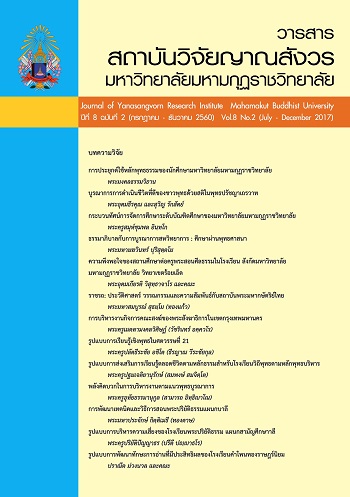MODEL BUDDHIST LEARNING IN THE 21st CENTURY
Main Article Content
Abstract
Research Style Buddhist learning in the 21st century aims. To study Buddhist learning and skills of knowledge in the 21st century is to develop skills in the 21st century with the principles of Buddhist learning. The present form of Buddhist learning in the 21st century. The study of Buddhist learning and skills of knowledge in the 21st century must be based on objective, conscientious and behavioral objectives. Focus on learning methods Self-discovery Self-assessment and improvement of practices that result perpetuity. A good friend who is a teacher guidance. Helped create an atmosphere of academic and environmental aesthetics. The process that senses the six pillars of human learning is the eyes, ears, nose, tongue, body, mind, experience and relationships to what we are elemental to know is feeling, perception, cognition, knowledge and action, interactive training manual. or the goodwill manifested by results Knowledge and good Acquisition of knowledge in the 21st century with the principles of Buddhist learning. Management perception sense and 6 as learning management along Buddhism through the entire third is behavior, physical and verbal (commandment) training habits of mind to calm things any distractions (concentration) development. the idea was to have a good attitude along the lines of the enlightened. Knowingly present to face the problem may not fear (IP), which is the process of learning by Buddhist six-step model based learning Buddhism in the 21st century include learning through the process of learning. both internal and external sense with 6 steps reinforced by learning skills follow the model LS 3R x 7C model.
Article Details
References
มหามกุฏราชวิทยาลัย. พระไตรปิฏกพร้อมอรรถกถาแปล. ชุด 91 เล่ม. กรุงเทพฯ : มหามกุฏราชวิทยาลัย. 2524.
กระทรวงศึกษาธิการ. พระราชบัญญัติการศึกษาแห่งชาติ ฉบับที่ 2 พ.ศ. 2552. กรุงเทพมหานคร: โรงพิมพ์องค์การรับส่งสิ้นค้าและพัสดุภัณฑ์. 2552.
คณะกรรมการการศึกษาแห่งชาติ. การเรียนรู้ขุมทรัพย์ใน. กรุงเทพมหานคร: คณะกรรมการการศึกษาแห่งชาติ. 2540.
จิราภรณ์ พิมพ์ใจใส. “การพัฒนารูปแบบการเรียนการสอนตามทฤษฎีการสร้างความรู้เพื่อส่งเสริมความสามารถในการเรียนรู้ของนักศึกษาพยาบาล”. วิทยานิพนธ์ดุษฎีบัณฑิต. บัณฑิตวิทยาลัย: มหาวิทยาลัยศิลปากร. 2552.
ดุษฎี สีตลวรางค์.การศึกษาในสังคมพระพุทธศาสนาตามที่ปรากฏในพระไตรปิฎก. วิทยานิพนธ์การศึกษาดุษฎีบัณฑิต.บัณฑิตวิทยาลัย จุฬาลงกรณ์มหาวิทยาลัย.2522. หน้า 172.
ประเวศ วะสี. ปฏิรูปการเรียนรู้ ผู้เรียนสำคัญที่สุด. พิมพ์ครั้งที่ 5. กรุงเทพมหานคร: คุรุสภาลาดพร้าว. 2542.
ประหยัด จิระวรพงศ์. การเรียนรู้ตามการพัฒนาของสมอง Brain-Based Learning:BBL. วารสารเทคโนโลยีการศึกษามหาวิทยาลัยบูรพา. ปีที่ 2 ฉบับที่ 1. กันยายน 2549.
พระธรรมปิฏก ป.อ. ปยุตฺโต. พุทธธรรม ฉบับปรับปรุงและขยายความ.พิมพ์ครั้งที่ 6. กรุงเทพมหานคร: โรงพิมพ์มหาจุฬาลงกรณราชวิทยาลัย. 2528.
วินัย วีระวัฒนานนท์. “หลักเกณฑ์และรูปแบบการพัฒนาหลักสูตรที่ พึงประสงค์ในระดับบัณฑิตศึกษา ทบวงมหาวิทยาลัย”. รายงานการวิจัย. กรุงเทพมหานคร: อรุณการพิมพ์. 2542.
สำนักงานคณะกรรมการการศึกษาแห่งชาติ. สรุปสาระสำคัญแนวทางการปฏิรูปการศึกษาระดับอุดมศึกษา. กรุงเทพมหานคร: พริกหวานกราฟฟิก. 2544.
สำนักงานปลัดทบวงมหาวิทยาลัย. รายงานการสัมมนาทางวิชาการเรื่องการปฏิรูป การเรียนการสอนและหลักสูตรในระดับอุดมศึกษา. กรุงเทพมหานคร: สำนักงานปลัดทบวงมหาวิทยาลัย. 2554.
สำนักงานปลัดทบวงมหาวิทยาลัย. รายงานการสัมมนาทางวิชาการเรื่องการปฏิรูป การเรียนการสอนและหลักสูตรในระดับอุดมศึกษา. สุมน อมรวิวัฒน์. หลักการเรียนรู้ตามแนวพุทธศาสตร์ ทักษะการเผชิญสถานการณ์. หน้า 12.
สุวิทย์ มูลคำ และอรทัย มูลคำ. เทคนิคแห่งความสำเร็จ: เรียนรู้สู่ครูมืออาชีพ. พิมพ์ครั้งที่ 6. กรุงเทพมหานคร: ภาพพิมพ์. 2544. ออนไลน์ วันที่ 2 มกราคม 2559 : ที่มา :http://www.vcharkarn.com/ varticle/60454


